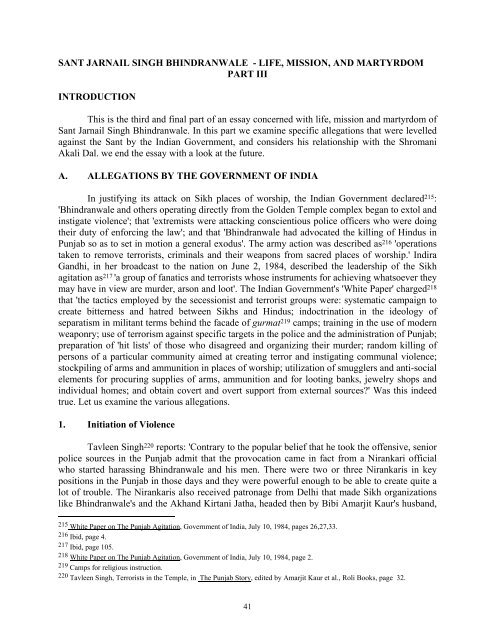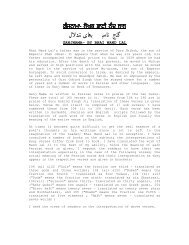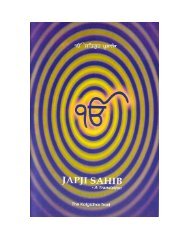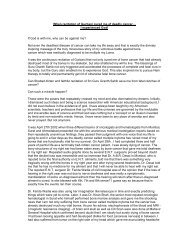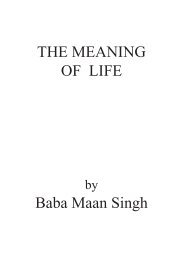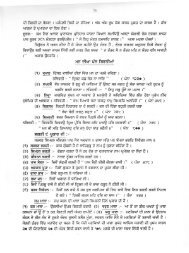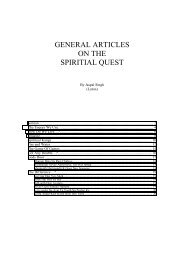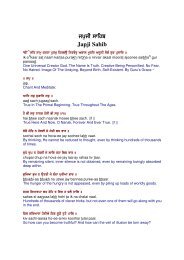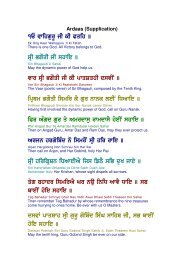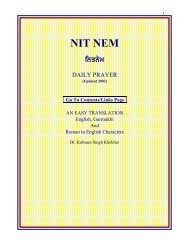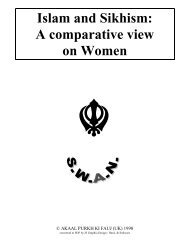SANT JARNAIL SINGH BHINDRANWALE - LIFE, MISSION, AND MARTYRDOMPART IIIINTRODUCTIONThis is the third and final part of an essay concerned with life, mission and martyrdom of<strong>Sant</strong> <strong>Jarnail</strong> <strong>Singh</strong> <strong>Bhindranwale</strong>. In this part we examine specific allegations that were levelledagainst the <strong>Sant</strong> by the Indian Government, and considers his relationship with the ShromaniAkali Dal. we end the essay with a look at the future.A. ALLEGATIONS BY THE GOVERNMENT OF INDIAIn justifying its attack on <strong>Sikh</strong> places of worship, the Indian Government declared 215 :'<strong>Bhindranwale</strong> and others operating directly from the Golden Temple complex began to extol andinstigate violence'; that 'extremists were attacking conscientious police officers who were doingtheir duty of enforcing the law'; and that '<strong>Bhindranwale</strong> had advocated the killing of Hindus inPunjab so as to set in motion a general exodus'. The army action was described as 216 'operationstaken to remove terrorists, criminals and their weapons from sacred places of worship.' IndiraGandhi, in her broadcast to the nation on June 2, 1984, described the leadership of the <strong>Sikh</strong>agitation as 217 'a group of fanatics and terrorists whose instruments for achieving whatsoever theymay have in view are murder, arson and loot'. The Indian Government's 'White Paper' charged 218that 'the tactics employed by the secessionist and terrorist groups were: systematic campaign tocreate bitterness and hatred between <strong>Sikh</strong>s and Hindus; indoctrination in the ideology ofseparatism in militant terms behind the facade of gurmat 219 camps; training in the use of modernweaponry; use of terrorism against specific targets in the police and the administration of Punjab;preparation of 'hit lists' of those who disagreed and organizing their murder; random killing ofpersons of a particular community aimed at creating terror and instigating communal violence;stockpiling of arms and ammunition in places of worship; utilization of smugglers and anti-socialelements for procuring supplies of arms, ammunition and for looting banks, jewelry shops andindividual homes; and obtain covert and overt support from external sources?' Was this indeedtrue. Let us examine the various allegations.1. Initiation of ViolenceTavleen <strong>Singh</strong> 220 reports: 'Contrary to the popular belief that he took the offensive, seniorpolice sources in the Punjab admit that the provocation came in fact from a Nirankari officialwho started harassing <strong>Bhindranwale</strong> and his men. There were two or three Nirankaris in keypositions in the Punjab in those days and they were powerful enough to be able to create quite alot of trouble. The Nirankaris also received patronage from Delhi that made <strong>Sikh</strong> organizationslike <strong>Bhindranwale</strong>'s and the Akhand Kirtani Jatha, headed then by Bibi Amarjit Kaur's husband,215 White Paper on The Punjab Agitation, Government of India, July 10, 1984, pages 26,27,33.216 Ibid, page 4.217 Ibid, page 105.218 White Paper on The Punjab Agitation, Government of India, July 10, 1984, page 2.219 Camps for religious instruction.220 Tavleen <strong>Singh</strong>, Terrorists in the Temple, in The Punjab Story, edited by Amarjit Kaur et al., Roli Books, page 32.41
Fauja <strong>Singh</strong>, hate them even more.' Khushwant <strong>Singh</strong> 221 tells us: 'Terrorist activity preceded themorcha 222 by more than six months and was born out of encounters faked by the Punjab policeand the armed conflict between the Nirankaris and <strong>Sant</strong> <strong>Bhindranwale</strong> beginning April 13, 1978.'<strong>Sant</strong> <strong>Jarnail</strong> <strong>Singh</strong> Bindranwale repeatedly declared 223 that he would never initiate a dispute or aconfrontation. However, he also asserted that if someone attacks a <strong>Sikh</strong>, he should get a properresponse. In his view 224 :'When is a <strong>Sikh</strong> wrong? It is when he poses a question. When is a <strong>Sikh</strong>'s sin washedaway? It is when he responds. A <strong>Sikh</strong> will never be the first to attack, to ask thequestion. Asking the question means being the first to attack. That is what we callasking a question. Later, seeking justice is called the answer. If we are sons of <strong>Sikh</strong>s,we shall never be the first to attack in the form of a question. Also, if we are sons of<strong>Sikh</strong>s, we shall never hesitate in responding. If we hesitate then we are artificial <strong>Sikh</strong>s,spoilt <strong>Sikh</strong>s, not real <strong>Sikh</strong>s. If we attack first then too we are spoilt <strong>Sikh</strong>s.'2. Attacks on 'Conscientious' Police OfficialsAs oppression against devout <strong>Sikh</strong>s escalated during 1982 and 1983, <strong>Sikh</strong>s from villagesflocked to <strong>Sant</strong> <strong>Jarnail</strong> <strong>Singh</strong> <strong>Bhindranwale</strong> seeking redress. At first he felt that there were someunscrupulous police officials who were responsible for the spate of arbitrary arrests followedgenerally by brutal torture and often resulting in death in police custody. He sought redress fromhigher authorities in the administration and from courts. Higher police officials listened to him,assured him of fairness but took no action. For example, referring to the assurances given by theInspector General of Police in the case of Harbhajan <strong>Singh</strong> and Harpreet <strong>Singh</strong>, <strong>Sant</strong><strong>Bhindranwale</strong> commented: 'Deviously, they keep telling the President (of the Shromani AkaliDal) on the phone that the boys have not committed any offense. If they are innocent then whyare they kept there, for fun? How long are we going to suffer this oppression?' The news mediaand the political leadership would not believe his charges of police brutality. The administration,instead of punishing the guilty policemen, rewarded them with promotions. He found that thecourts were powerless in enforcing their decisions. For example 225 :'At the time of Amrik <strong>Singh</strong>'s arrest, Puran <strong>Singh</strong> Hundal, his lawyer, went to thejudge. He petitioned the judge and after submitting the petition came and met the(police) officers. He said to the officers: "Here is his (Amrik <strong>Singh</strong>'s) petition to thejudge and the judge's signature. The lawyer can stay (with the accused)." The officers atthat place told him: "We do not know the judge. Here, we are the judges." The lawyerwent back to the judge and told him: "Sir, here is your signature. These are your ordersand the officers say they do not know the judge and that they are the judges." The judgefolded his hands and said that this was not in his power. Where will you go? When221 Khushwant <strong>Singh</strong>, The Brink of the Abyss, in Punjab, The Fatal Miscalculation, Edited by Patwant <strong>Singh</strong> and Harji Malik,Patwant <strong>Singh</strong>, New Delhi, 1985, page 130.222 Morcha is the word generally used by <strong>Sikh</strong>s for any campaign: here it refers to the agitation started on August 4, 1982.223 For example, <strong>Sant</strong> <strong>Jarnail</strong> <strong>Singh</strong> <strong>Bhindranwale</strong>, Speech on May 18, 1983; and Harry Reasoner's report on CBS '60 minutes'.224 <strong>Sant</strong> <strong>Jarnail</strong> <strong>Singh</strong> <strong>Bhindranwale</strong>, Speech on December 31, 1983.225 <strong>Sant</strong> <strong>Jarnail</strong> <strong>Singh</strong> <strong>Bhindranwale</strong>, Speech on March 1, 1983.42


